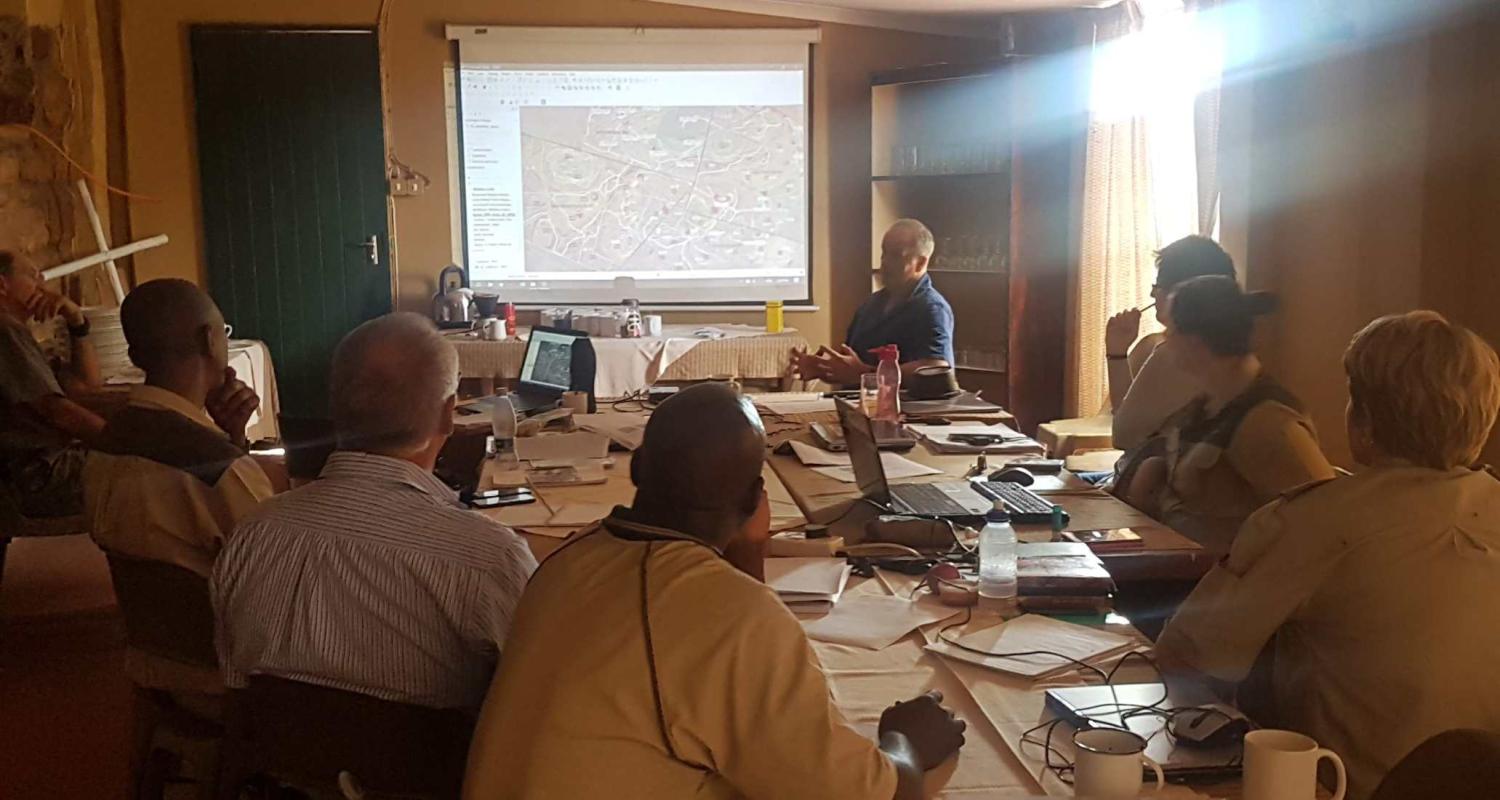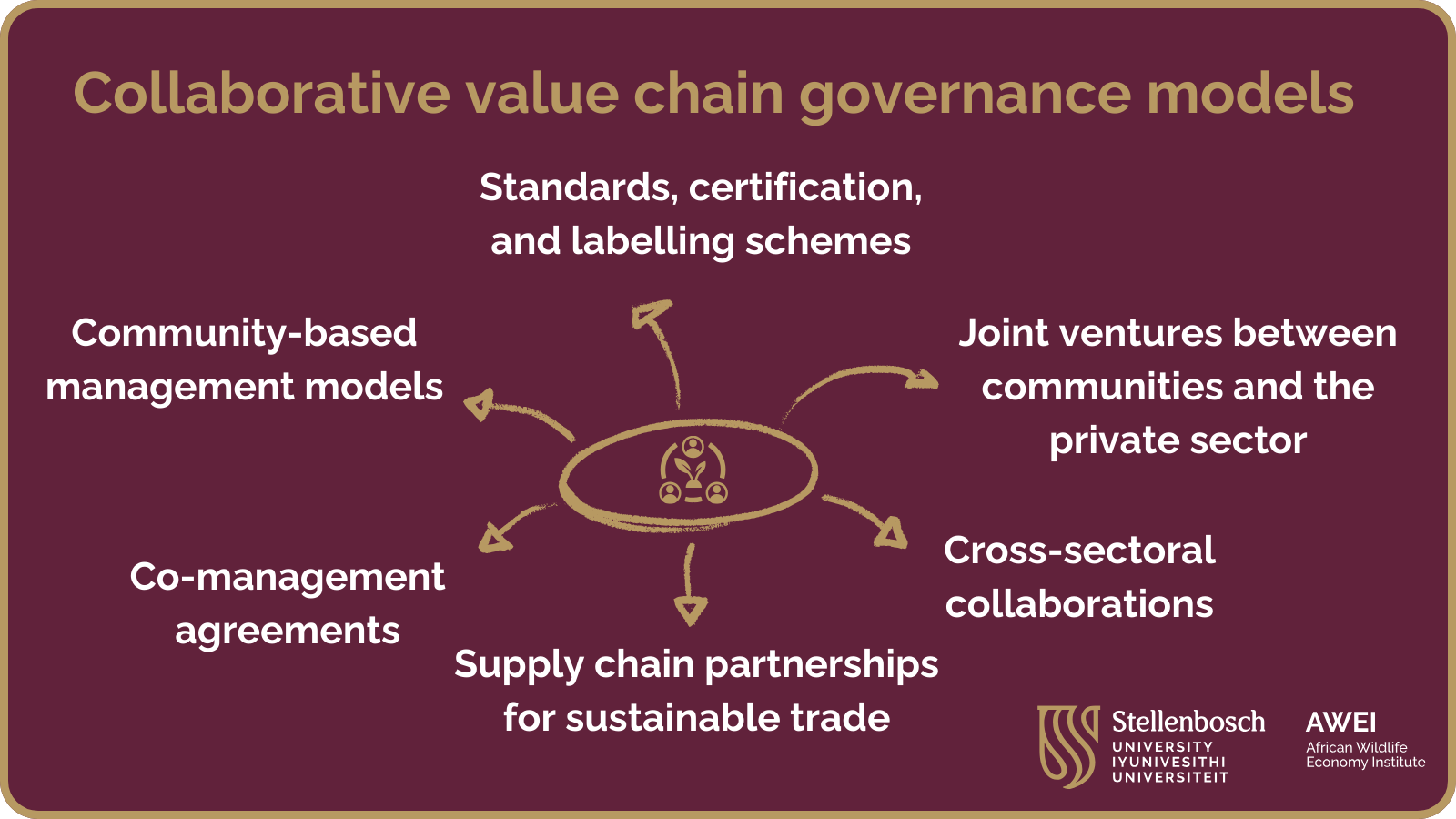
Collaborative governance models of wild product value chains for conservation and livelihood resilience
Millions of resource-constrained households that live in woodlands in tropical and subtropical areas depend on wild products as a vital supply of food and fuel and as a source of revenue. However, these communities' livelihoods are currently in jeopardy due to a growing demand for wild products and unsustainable harvesting rates (Angelsen et al., 2014). This means the health of ecosystems is also at risk. In this article, we look at how various collaborative value chain governance models can be used as instruments for sustainable use, conservation, and livelihood resilience.
Sustainable utilisation of wild products, such as non-timber forest products, wild meat, and medicinal plants, requires governance models that ensure environmental sustainability, social equity, and economic viability. Collaborative value chain governance models present an opportunity for achieving these objectives by facilitating cooperation among various stakeholders to enhance efficiency, sustainability, and competitiveness. Here we briefly discuss examples of such models applicable to the sustainable utilisation of wild products.

Community-based management model (CBM)
CBM model involves local communities in the management, harvesting, and selling of wild products. Emphasis is put on the premise that local communities if given rights and responsibilities, are capable of managing natural resources sustainably. The model adopts a collaborative approach between communities, governments, and non-governmental organisations (NGOs) to develop management plans that ensure the conservation of resources while allowing for their utilisation. For example, A study in Costa Rica showed that Community-Based Tourism (CBT) and support organisations are champions of local economic linkages and are successful in promoting wider benefits that are placed on small linkages to services and products provided by local community members (Trejos & Chiang, 2009).
Standards, certification, and labelling schemes
There are also standards and certification schemes, such as those developed by the Forest Stewardship Council (FSC) for timber and non-timber forest products or the Marine Stewardship Council (MSC) for seafood, which provide governance frameworks where producers, buyers, and certifying bodies collaborate to ensure sustainable practices. Other organisations include FairWild Foundation and Wildlife Friendly Enterprise Network. These do not only certify businesses but work with all actors involved in the wild products value chains – i.e. from the collectors, traders/processors, and distributors to monitor and evaluate sustainability. Moreso, they ensure businesses and entrepreneurs are ethical by being fair to their workers and ensuring consumers receive fair prices for the final products. Certified products are labelled as such, providing consumers with the assurance that the products are sustainably sourced. This can lead to premium prices and improved market access for producers.
Joint ventures between communities and the private sector
This model involves partnerships between local communities that have access to wild products and private sector entities that have the capital, technology, and market access. These also lie realm of called Private Public Sector Partnership (PPP). Co-agreements agreement could take the form of a contractual arrangement between a protected area authority (government, private, or community) and a partner (private or NGO) to collaboratively manage a protected area. Through PPP, the protected area authority devolves certain management responsibilities and in most cases funding obligations to the partner. The duration of the contract varies and depends on the goals of the PA authority.
For example, wildlife conservation initiatives frequently collaborate with private sector companies and local communities to safeguard endangered animals and their natural environment. These joint ventures aim to ensure that benefits are shared equitably and that harvesting practices are sustainable. They often involve agreements on profit-sharing, community development initiatives, and sustainable harvesting practices. An example of a private-community partnership is that of the Community-Based Tourism partnership where the private sector collaborated with Goo-Moremi residents in Botswana (Elijah, Moswete & Mpotokwane, 2022). The project has been successful with residents beginning to reap benefits from heritage tourism and the joint partnerships in managing heritage. Benefits include job creation, income generation, and heightened knowledge of conservation and protection of local heritage sites and resources.
Supply chain partnerships for fair trade
Fair-trade models focus on improving the livelihoods of wild product producers through ethical trading conditions. Supply chain partnerships under Fair Trade models involve producers, traders, and retailers working together to ensure that producers receive fair prices and that they meet social and environmental standards. These partnerships often include capacity building for producers and community development projects. For example, coffee is one of the most well-known fair-trade products. Organisations such as Fair-Trade USA and Fair-Trade International collaborate with coffee growers to guarantee sustainable environments, decent incomes, and safe working conditions (Lee & Bateman, 2021).
Co-management agreements
Co-management agreements involve shared governance of wild resources between governments and local communities or indigenous people. Co-management agreements define roles, responsibilities, and benefit-sharing mechanisms, aiming to balance conservation needs with the livelihoods of people who depend on wild products. They typically involve collaborative decision-making processes, joint monitoring, and adaptive management practices. In Namibia, Community-Based Natural Resource Management (CBNRM) provide a strong model for other countries. The model devolves secure legal rights to local people towards promoting positive outcomes both in terms of conservation and economic development (Boudreaux, 2007). Similarly, Community Areas Management Program for Indigenous Resources (CAMPFIRE) programme in Zimbabwe is also co-management agreement between communities and government. This programme through Parks and Wildlife Act of 1975 allows communities and private landowners to use wildlife on their land. This move marked a substantial shift from colonial policy that made it illegal for local populations to utilize wildlife in any way.
Cross-sectoral collaborations
Cross-sectoral collaborations unite actors from different sectors (e.g., conservation, health, and agriculture) to address complex issues related to the sustainable utilisation of wild products. For example, collaborations between conservation organizations and health sectors can address the sustainable use of medicinal plants, ensuring both health and economic benefits as well as biodiversity conservation. The United Nations Environment Programme, The World Agroforestry Centre, Banque Nationale de Paris Paribas (bank), and ADM Capital collaborated to form the Tropical Landscapes Finance Facility (TLFF) to mobilize finance for long-term sustainability initiatives that promote green economic growth and sustainable rural livelihoods across Indonesia’s 17,000 islands for agriculture and ecosystem restoration (Mack-heller, 2021).
Conclusion
The examined models of collaborative governance have encouraging prospects for tackling the double issues in the value chains of livelihood resilience and sustainable use of wild products. These models demonstrate complex relationships that exist between social equity, environmental sustainability, and economic viability. All of these are critical to the long-term well-being of value chain ecosystems and the communities that depend on natural capital. To put it simply, putting collaborative governance models into practice is a comprehensive strategy for handling the intricate problems that wild product exploitation and value chains face. These models can improve the resilience of wild product enterprises as well as livelihoods reliant on natural resources. Simultaneously, biodiversity conservation and ecosystem health are maintained through cooperation, transparency, and inclusivity. Going forward, the management and governance of wild products value chain networks could be improved to attain sustainable development and benefit people and the environment.
References
We support the free flow of information. Please share:
More content
-

What Foot and Mouth Disease-free means for South Africa’s game meat trade
Ms Lydia Daring Bhebe…Explore the latest developments in South African provinces achieving and maintaining Foot and Mouth Disease (FMD) free status…
Articles -

The world wildlife trade regulator is 50 – here’s what has worked and what needs to change
Daniel Challender…Most countries implement Cites, the Convention on International Trade in Endangered Species of Wild Fauna and Flora as…Articles -

Enabling Sustainable Wildlife Trade
Prof Francis VorhiesEnabling sustainable wildlife trade is a key policy measure for growing Africa's wildlife economy. In this respect, CITES…
Articles -

Has CITES become too complicated to be effective?
Prof Francis VorhiesGovernments agreed to the text of CITES in the 1970s, which is quite straightforward. However, the agreement’s implementation…
Articles -

From poachers to providers: Can Africa's wild meat market save wildlife?
Dr Wiseman NdlovuHave you ever considered how wild meat could be more than just a cultural staple but also a…
Articles -

As a fellow of the African Wildlife Economy Institute (AWEI), I am excited to attend the upcoming 3rd…
Articles -

A theory of change to improve conservation outcomes through CITES
Dr Michael 't Sas-Rolfes…Here we articulate the implied theory of change (ToC) underpinning the design and operation of CITES (Convention on...
2025Research -

Wild Meat Value Chain Integration Systems: Opportunities for Value Chain Formalisation and Scaling in Africa
Dr Wiseman Ndlovu…Establishing a legal, safe and sustainable wild meat sector promises to potentially reduce demand for illegally sourced meat...
2025Research -

AWEI's 2024 Wildlife Economy Dialogue Series
Ms Emily TaylorRediscover 2024: A year of insight and inspiration
In 2024, AWEI proudly hosted three ground-breaking dialogue series in…
Articles
Get updates by email
Through impactful research, stakeholder engagement, and professional development, AWEI is supporting the wildlife economy across Africa. Please subscribe for occasional updates on our work and forthcoming events.
Sign up for a quarterly dose of AWEI insights
In a complex and changing world, AWEI generates strategic ideas, conducts independent analysis on wildlife economies, and collaborates with global scholar-practitioners to provide training and expertise for biodiversity conservation, climate resilience, and inclusive economic opportunities in Africa.

